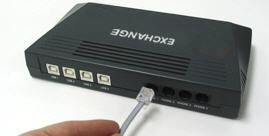Nice effort, VoSKY, but just the name "Skype" is a no-deploy zone for enterprise IT

On Friday, I spoke to David Tang, CEO of network gateway-maker VoSKY.
He wanted to offer his perspective on a blog post I authored the previous week, in which I wrote why Skype VoSKY Exchange gateways have a big task ahead.
I wrote:
Third-party Skype solutions developer VoSKY announced earlier this week that the Skype VoSKY Exchange range of rack-mountable PBX-to-Skype gateways are now available worldwide.
The VoSKY Exchange 9040 (shown above) and 9140 gateways are being positioned as a way for businesses to bridge landlines or cellphone connections by using SkypeOut calls from standard office phones. Each enables Click-to-Call, PBX Remote Access, Multi-site PBX Networking and Skype Trunking with existing phone systems.
Here’s the gist of how the 9040 and 9140 gateways work- as VoSKY explains it:
The 9040 FXS gateway model offers trunk-side connectivity to the PBX. The 9140 FXO gateway connects on the station-side and adds the ability to transfer Skype calls between offices by extension without dialing the full office number. Both models of Skype VoSKY Exchange add four Skype lines to the office PBX.
My own take is that this solution will, at least initially, be more readily accepted at medium-size businesses than larger enterprises. I’ve seen a virtual allergy toward anything Skype at the larger enterprises. The medium-size businesses I’ve interacted with personally and professionally seem, on balance, to be more hesitant about using Skype due to the fear of unfamiliarity rather than reflexive scorn.
Still, the challenges are plain.
It will take vigorous sales work by VoSKY to convince some of the Skype-allergic VARs and medium-sized businesses themselves that VoSKY Exchange-Skype is an efficient and secure solution.
David wanted to shed perspective on the challenges I mentioned.
At the start of our conversation, David says he sees how it could be finicky for IT types to put another application on the desktop. That and giving them headsets, is a complicated dilemma.
"What we do is give the enterprise the options to leverage Skype by giving them a server with its sole purpose in life to process Skype calls," David told me, framing a key element of his argument that VoSKY Exchange is a solution ready for the enterprise. "Instead of a PSTN or SIP network going out to Skype, these calls can be isolated from the network, be behind the firewall and not on the LAN."
David then mentioned that such solutions would also be a way to securely facilitate SkypeMe buttons on sites.
I admire David's determination and innovativeness, but I still think there is a mental block in enterprise IT about installing or enabling anything to do with Skype. Even if Skype is quarantined away from the LAN.
IT network and security types are paid to worry. Old assumptions die hard, and this one- abut Skype not being enterprise-ready- will take years to go away. If that.
